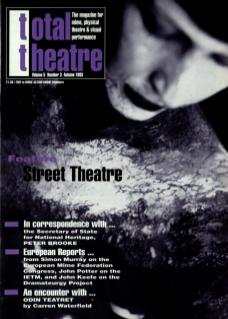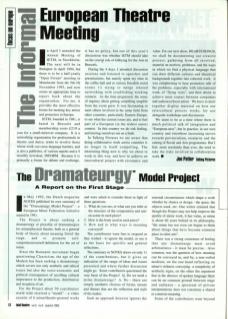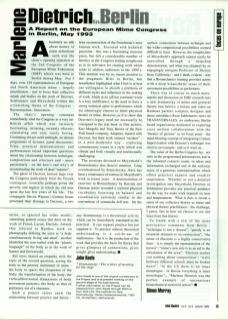In May 1993, the Dutch magazine Notes published its own summary of the ‘Dramaturgy Model Project’ – a European Mime Federation initiative started in 1991.
The Project is about seeking a dramaturgy or plurality of dramaturgies for mime/physical theatre, both as a general body of theory about meaning for/of the stage, and to promote self-comprehension/self-definition for the art of mime.
Since the Romantic movement began questioning Classicism, the age of the Modern has been seeking a dramaturgy which covers not only aesthetic and ethical issues but also the socio-economic and political consequences of ascribing cultural importance to the production, distribution and reception of art.
For the Project about 50 contributors worldwide received a ‘model’ – a video cassette of six mime/theatre-gestural works and were asked to consider them in light of three questions:
1. What do you see, or what can you infer as the structure of the composition and mis-en-scene in each piece?
2. How is the body used in each piece?
3. How and in what ways is meaning conveyed?
The contributors were free to respond as they wished – to ignore the model, or use it as the basis for specific and general reflections.
The summary in Notes draws on only eleven of the contributions, but it gives an indication of the range of ideas and issues presented and where further discussion might go. Some contributors questioned the very basis of the Project! Q. Do we need a mime dramaturgy? A. No – there are simply aesthetic choices of forms, means and themes that are the reflection and style of the maker.
Such an approach however ignores the external circumstances which shape a work whether by chance or design – the space, the objects used, etc. One writer claimed that though the Project may not help improve the quality of mime work, it has value, as mime is about 60 years behind in its philosophy: ‘the mime has not even yet begun to think about things that have become common place in other arts’.
There was a strong consensus of feeling that any dramaturgy must avoid arbitrariness – it must be precise. Also common was the question of how meaning can be conveyed in, and by, a non-verbal medium; on the one hand reflecting on mime's richness conveying a complexity of aesthetic signs, on the other the argument that in the absence of spoken language there can be no common ground between stage and audience – a spectrum of private interpretations does not constitute a shared or common meaning.
Some of the contributors went beyond mime, or ignored the video model, submitting general essays that drew on the work of Freud, Lacan, Derrida, Artaud. One referred to Barthes’ work on photography defining the actor as ‘a body simultaneously living and dead’, another identified the non-verbal with the ‘plastic language’ of the body as in the work of Kantor and Grotowski.
But most shared an empathy with the topic of the second question, seeing the body as the primary instrument of mime – the body in space; the eloquence of the body; the transformation of the body; the vertical/horizontal dimensions of body movement patterns; the body as that of performer, not of a character.
Such a project raises anew the relationship between practice and theory – any dramaturgy is a theoretical activity which can be immediately translated to the practical. It can support practice but not supplant it. To practice without theoretical understanding is a cul-de-sac of shallowness – but it is the production of the work that provides the basis for theory that gives glimpses of connections, gives insight, gives understanding.
John Keefe is one of the original contributors to the Project and is at present working on the second stage of his submissions. Further information on the Project can be obtained from John Keefe through MAG or from Rob List, The Institute for New Dramateurgy, Derde Oosterparkestratt, 1092 CS, Amsterdam, Netherlands.


